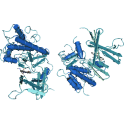
- Remove this product from my favorite's list.
- Add this product to my list of favorites.
Products
Newsletter
 |  |  |  |  |  |

Background: Extracellular signal-regulated kinase (ERK) is a serine/threonine protein kinase that functions as the major effector of the Ras protein, a small GTPase. The so called “ERK cascade” consists of three enzymes, the initial GTPase-regulated kinase Raf, (MAP3K) that phosphorylates and activates an intermediate kinase MEK (MAP2K) that, in turn, phosphorylates a threonine and a tyrosine residue of the activation loop of the effector kinase ERK (MAPK). Both, ERK1 and ERK2 share a high sequence identity (90%) and are co-expressed in most tissues but differ in their relative abundance. The substrate specificities of the ERK1 and ERK2 protein kinases are very similar. The consensus sequence for ERK1 substrates has been identified as -Pro- Leu-Ser/Thr-Pro. Both kinases are involved in proliferation, differentiation, cell cycle processes, and survival. ERK1 / 2 differentially phosphorylates a variety of nuclear (Elk-1, c-Myc), cytosolic (MNK1/2, Raf) and cytoskeletal (MAP2, Tau) targets. Since the ERK pathway is often up-regulated in human tumors it represents an attractive target for anticancer drugs development.
Human ERK1, recombinantly expressed in E. coli. Highly active form produced by phosphorylation of the purified ERK1 in vitro with MEK1 followed by subsequent purification using affinity chromatography.
Expression system: E.coli
Molecular weight (His fusion protein): 44.5 kDa
Protein concentration: 0.22 mg/ml (Bradford with BSA as standard)
Storage buffer: 50 mM Tris-HCl, 100 mM NaCl, 1 mM DTT, 50 % glycerol, pH 8.5
Purity: > 95% by SDS PAGE
Specific activity: 125,100 U*/mg (1 Unit is defined as 1 picomole phosphate transferred to myelin basic protein per min at 30 °C)
Entrez Gene ID: 5595
UniProtKB: P27361
Ordering information: shipped on dry ice
Seger R, Ahn NG, Krebs EG et al. (1991) "Microtubule-associated protein 2 kinases, ERK1 and ERK2, undergo autophosphorylation on both tyrosine and threonine residues: implications for their mechanism of activation" Proc Natl Acad Sci USA 88(14):6142-6
Gonzalez FA, Raden DL, Davis RJ (1991) "Identification of substrate recognition determinants for human ERK1 and ERK2 protein kinases" J. Biol. Chem. 266(33):22159-63
Haycock JW, Ahn NG, Cobb MH, Krebs EG (1992) "ERK1 and ERK2, two microtubule-associated protein 2 kinases, mediate the phosphorylation of tyrosine hydroxylase at serine-31 in situ" Proc. Natl. Acad. Sci. USA 89(6):2365-9
Meloche S, Pages G, Pouyssegur J (1992) "Functional expression and growth factor activation of an epitope-tagged p44 mitogen-activated protein kinase, p44mapk" Mol Biol Cell 3(1):63-71
Cook SJ, Rubinfeld B, Albert I, McCormick F (1993) "RapV12 antagonizes Ras-dependent activation of ERK1 and ERK2 by LPA and EGF in Rat-1 fibroblasts" EMBO J. 12(9):3475-85
Pages G, Lenormand P, Pouyssegur J et al (1993) "Mitogen-activated protein kinases p42mapk and p44mapk are required for fibroblast proliferation" Proc Natl Acad Sci U S A 90(18):8319-23
Lenormand P, Sardet C, Pouyssegur J et al (1993) "Growth factors induce nuclear translocation of MAP kinases (p42mapk and p44mapk) but not of their activator MAP kinase kinase (p45mapkk) in fibroblasts" J Cell Biol. 122(5):1079-88
Volente C, Angelastro JM, Greene LA (1993) "Association of protein kinases ERK1 and ERK2 with p75 nerve growth factor receptors" J. Biol. Chem. 268(28):21410-5
Hartsough MT, Mulder KM (1995) "Transforming growth factor beta activation of p44mapk in proliferating cultures of epithelial cells" J Biol Chem. 270(13):7117-24
Songyang Z, Lu KP, Cantley LC et al. (1996) "A structural basis for substrate specificities of protein Ser/Thr kinases: primary sequence preference of casein kinases I and II, NIMA, phosphorylase kinase, calmodulin-dependent kinase II, CDK5, and Erk1" Mol Cell Biol. 16(11):6486-93
Veeranna, Amin ND, Ahn NG, Jaffe H, Winters CA, Grant P, Pant HC (1998) "Mitogen-activated protein kinases (Erk1,2) phosphorylate Lys-Ser-Pro (KSP) repeats in neurofilament proteins NF-H and NF-M" J. Neurosci. 18(11):4008-21
Pages G, Guerin S, Pouyssegur J (1999) "Defective thymocyte maturation in p44 MAP kinase (Erk 1) knockout mice" Science 286(5443):1374-7
Brondello JM, Pouyssegur J, McKenzie FR (1999) "Reduced MAP kinase phosphatase-1 degradation after p42/p44MAPK-dependent phosphorylation" Science 286(5449):2514-7
Lu Z, Xu S, Joazeiro C, Cobb MH, Hunter T (2002) "The PHD domain of MEKK1 acts as an E3 ubiquitin ligase and mediates ubiquitination and degradation of ERK1/2" Mol Cell 9(5):945-56
Mazzucchelli C, Vantaggiato C, Brambilla R et al. (2002) "Knockout of ERK1 MAP kinase enhances synaptic plasticity in the striatum and facilitates striatal-mediated learning and memory" Neuron 34(5):807-20
Follow us